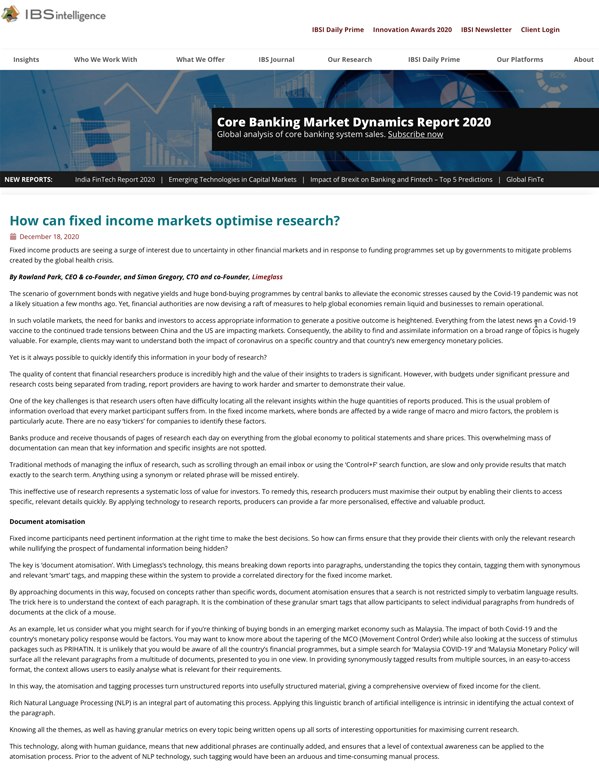How can fixed income markets optimise research?
Fixed income products are seeing a surge of interest due to uncertainty in other financial markets and in response to funding programmes set up by governments to mitigate problems created by the global health crisis.
By Rowland Park, CEO & co-Founder, and Simon Gregory, CTO and co-Founder, Limeglass
The scenario of government bonds with negative yields and huge bond-buying programmes by central banks to alleviate the economic stresses caused by the Covid-19 pandemic was not a likely situation a few months ago. Yet, financial authorities are now devising a raft of measures to help global economies remain liquid and businesses to remain operational.
In such volatile markets, the need for banks and investors to access appropriate information to generate a positive outcome is heightened. Everything from the latest news on a Covid-19 vaccine to the continued trade tensions between China and the US are impacting markets. Consequently, the ability to find and assimilate information on a broad range of topics is hugely valuable. For example, clients may want to understand both the impact of coronavirus on a specific country and that country’s new emergency monetary policies.
Yet is it always possible to quickly identify this information in your body of research?
The quality of content that financial researchers produce is incredibly high and the value of their insights to traders is significant. However, with budgets under significant pressure and research costs being separated from trading, report providers are having to work harder and smarter to demonstrate their value.
One of the key challenges is that research users often have difficulty locating all the relevant insights within the huge quantities of reports produced. This is the usual problem of information overload that every market participant suffers from. In the fixed income markets, where bonds are affected by a wide range of macro and micro factors, the problem is particularly acute. There are no easy ‘tickers’ for companies to identify these factors.
Banks produce and receive thousands of pages of research each day on everything from the global economy to political statements and share prices. This overwhelming mass of documentation can mean that key information and specific insights are not spotted.
Traditional methods of managing the influx of research, such as scrolling through an email inbox or using the ‘Control+F’ search function, are slow and only provide results that match exactly to the search term. Anything using a synonym or related phrase will be missed entirely.
This ineffective use of research represents a systematic loss of value for investors. To remedy this, research producers must maximise their output by enabling their clients to access specific, relevant details quickly. By applying technology to research reports, producers can provide a far more personalised, effective and valuable product.
Document atomisation
Fixed income participants need pertinent information at the right time to make the best decisions. So how can firms ensure that they provide their clients with only the relevant research while nullifying the prospect of fundamental information being hidden?
The key is ‘document atomisation’. With Limeglass’s technology, this means breaking down reports into paragraphs, understanding the topics they contain, tagging them with synonymous and relevant ‘smart’ tags, and mapping these within the system to provide a correlated directory for the fixed income market.
By approaching documents in this way, focused on concepts rather than specific words, document atomisation ensures that a search is not restricted simply to verbatim language results. The trick here is to understand the context of each paragraph. It is the combination of these granular smart tags that allow participants to select individual paragraphs from hundreds of documents at the click of a mouse.
As an example, let us consider what you might search for if you’re thinking of buying bonds in an emerging market economy such as Malaysia. The impact of both Covid-19 and the country’s monetary policy response would be factors. You may want to know more about the tapering of the MCO (Movement Control Order) while also looking at the success of stimulus packages such as PRIHATIN. It is unlikely that you would be aware of all the country’s financial programmes, but a simple search for ‘Malaysia COVID-19’ and ‘Malaysia Monetary Policy’ will surface all the relevant paragraphs from a multitude of documents, presented to you in one view. In providing synonymously tagged results from multiple sources, in an easy-to-access format, the context allows users to easily analyse what is relevant for their requirements.
In this way, the atomisation and tagging processes turn unstructured reports into usefully structured material, giving a comprehensive overview of fixed income for the client.
Rich Natural Language Processing (NLP) is an integral part of automating this process. Applying this linguistic branch of artificial intelligence is intrinsic in identifying the actual context of the paragraph.
Knowing all the themes, as well as having granular metrics on every topic being written opens up all sorts of interesting opportunities for maximising current research.
This technology, along with human guidance, means that new additional phrases are continually added, and ensures that a level of contextual awareness can be applied to the atomisation process. Prior to the advent of NLP technology, such tagging would have been an arduous and time-consuming manual process.
How does this help fixed income markets?
Such a methodology not only offers a relevant, detailed and convenient manner of consuming reports, but also means that the results are – by their nature – personalised to the user. In today’s complex financial industry, a one-size-fits-all approach to research cannot provide the level of relevance and detail which market participants require. With increasing capabilities for using technology, a lack of personalised output is a loss of opportunity.
A firm may know what areas of fixed income their clients are interested in, but if there is no ability to only surface or distribute the precise topics the readers are interested in, the material will be of limited value and may not be read or fully appreciated. In disseminating specific paragraphs, the time and cost savings bring extensive benefits to both the firm and its clients.
With this technology, the recipient can assess the relevance of any fixed income reports much more quickly, and in so doing, the consequence is an enhanced relationship between the research producer and the client.
A personalised flow of information will lead to better informed fixed income trading decisions. Moreover, the process provides a competitive edge for research firms and thereby leads to business success.
News & Insights
Rowland Park
CEO & Co-Founder





